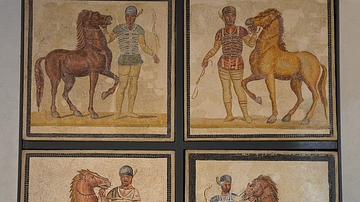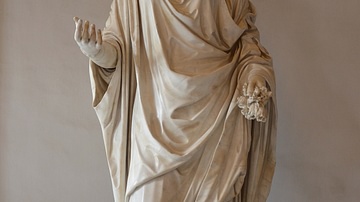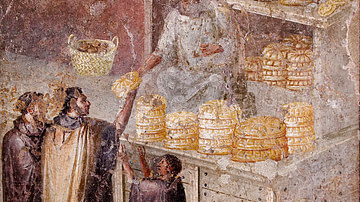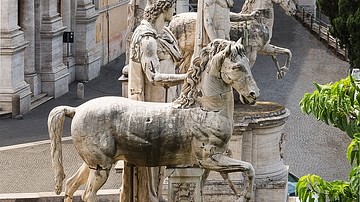Search
Did you mean: Circe?
Search Results

Lesson Pack
Roman Innovations and Architecture
We have prepared two lesson plans including classroom activities, assignments, homework, and keys as well as: Glossary of keywords and concepts in an excel format Open questions adaptable for debates, presentations, and essays Recommended...

Image
Roman Mosaic with Charioteers
Mosaic depicting a charioteer and horse from each of the four circus factions (Red, White, Blue, and Green), 3rd century CE (Palazzo Massimo all Terme, Rome). Chariot-racing was the most popular sport in ancient Rome, and the Blues and Greens...

Image
Roman Goddess Flora
Flora was the Roman goddess of flowers, vegetation and fertility. Spring was her season and her temple stood near the Circus Maximus in Rome. Her festival, called the Floralia, was instituted in 238 BCE. This Roman artwork from the Hadrianic...

Quiz
Daily Life in Ancient Rome
Daily life ancient Rome villa insula domus atrium compluvium cubiculum culina impluvium lararium peristylium posticum tablinum taberna triclinium vestibulum paterfamilias materfamilias Circus Maximus factions amphitheater Colosseum baths...

Collection
The Architecture of Ancient Rome
Roman architecture was nothing if not eclectic. From ingenious underfloor heating to gravity-defying arches, the Romans added to the Classical repertoire such grandiose structures as the triumphal arch, basilica, amphitheatre, and city tower...

Video
Portico of Octavia - Ancient Rome Live
The Portico of Octavia in the Circus Flaminius, part of the southern Campus Martius, was the monumental entrance to a complex with two temples - Jupiter and Juno- surrounded by porticoes. The first on the spot was 2nd Century BCE, built...

Definition
Romulus and Remus
In Roman mythology, Romulus and his twin brother Remus were the founders of the city of Rome. They were the children of Rhea Silvia and Mars (or in some variations the demi-god hero Hercules) and their story is recorded by many authors including...

Definition
D-Day
D-Day was the first day of Operation Overlord, the Allied attack on German-occupied Western Europe, which began on the beaches of Normandy, France, on 6 June 1944. Primarily US, British, and Canadian troops, with naval and air support, attacked...

Definition
Castor and Pollux
Castor and Pollux (the Dioscuri) are figures from Greek and Roman mythology considered the twin sons of Zeus or Jupiter. Semi-divine figures, the twins were credited with the role of saving those in trouble at sea or in grave danger in war...

Definition
Helios
Helios (also Helius) was the god of the Sun in Greek mythology. Helios rode a golden chariot which brought the Sun across the skies each day from the east (Ethiopia) to the west (Hesperides). Helios was famously the subject of the Colossus...